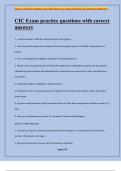EMILLECT 2024/2025 ACADEMIC YEAR ©2024 EMILLECT. ALL RIGHTS RESERVED. FIRST PUBLISH OCTOBER 2024.
CIC Exam practice questions with correct
answers
1. I was discovered in 1894 by a Swiss physician in Hong Kong
2. I was the causative agent of an epidemic that tore through Europe in the 1300s, killing millions of
people
3. I am a rod shaped Gram-negative, facultative anaerobic bacterium
4. People most commonly become infected when bitten by an infected flea; however can also become
infected from direct contact with infected fluids or tissues from an animal that is sick or has died from
the disease.
5. Three types: Bubonic, septicemic, and pneumonic
6. Symptoms of me may vary based on form. Bubonic form presents with swollen, tender and painful
lymph nodes.
7. A person usually becomes ill with the bubonic form 2-6 days after being infected. Airborne route is 1-3
days.
8. There are still sporadic cases in the US - Answer✔✔-Yersinia pestis (Plague)
Who am I? #MicroMonday
1. I am box-car shaped, anaerobic gram-positive that forms spores. I'm sensitive to heat and cannot
survive in the presence of oxygen.
2. My spores are found in the soil, and in animal feces and teeth.
Page 1/19
,EMILLECT 2024/2025 ACADEMIC YEAR ©2024 EMILLECT. ALL RIGHTS RESERVED. FIRST PUBLISH OCTOBER 2024.
3. The spore form can remain inactive in the soil, but can remain infectious for more than 40 years!
4. Infection occurs when my spores enter the body through an injury or wound. Time to infection ranges
from 7-21 days.
5. Disease from me often begins with mild spasms in the jaw muscles, but can also affect the chest, neck,
back, and abdominal muscles.
6. Other symptoms: drooling, excessive sweating, fever, hand or foot spasms, irritability, swallowing
difficulty, urinary or bowel incontinence
7. Back spasms often cause arching, also called opisthotonos
8. There are no hospital labs that can diagnose the disease. Treatment includes hospitalization, TIG,
vaccine, drugs to control spasms, wound car - Answer✔✔-Clostridium tetani
Who am I? #MicroMonday
1) I am a microscopic parasite that infects red blood cells.
2a) I am transmitted by the bite of infected Ixodes scapularis ticks (deer ticks).
2b) While deer are an important food source for adult ticks, they're not infected with me. I normally
infect white-footed mice, small mammals, and humans.
3a) Transmission most commonly occurs during the warm months in the Northeast and upper Midwest
and is spread by the young nymph stage of the tick.
3b) These are normally the size of a poppy seed, and may be referred to by locals as a "seed tick".
4a) Most infections are asymptomatic.
Page 2/19
, EMILLECT 2024/2025 ACADEMIC YEAR ©2024 EMILLECT. ALL RIGHTS RESERVED. FIRST PUBLISH OCTOBER 2024.
4b)Some may present with flu-like symptoms, such as fever, chills, sweats, headache, body aches,
anorexia, nausea, or fatigue.
5) I can cause hemolytic anemia from destruction of red blood cells.
6) Symptoms, if present, can begin approximately a week after infection. For others, symptoms may take
weeks or months to deve - Answer✔✔-Babesiosis (Babesia microti)
Who am I? #MicroMonday
1. I am an obligate aerobic Gram-negative rod that does not ferment glucose and is catalase positive.
2. First described by Walter Burkholder in 1949 as the cause of bacterial rot of onion bulbs.
3. I was originally included in the Pseudomonas genus.
4. I can be found in soil, water, infected plants, animals, and humans
5. I am capable of breaking down toxic compounds found in pesticides and herbicides.
6. I have shown resistance to some disinfectants
7. I commonly hold penA gene, which aids in resistance to β -lactam antibiotics.
8. I normally have a higher resistance to first and 2nd generation cephalosporins; may show resistant to
imipenem, but not meropenem.
9. I am commonly found in cystic fibrosis patients and those who are immunocompromised; have been
implicated in healthcare outbreaks, especially from aqueous environments and irrigants
10. Treatment for resistant strains may include min - Answer✔✔-Burkholderia cepacia
For annual screening of employees for tuberculosis, a PPD/TST skin test of 15 mm of induration, 48 to 72
hours after administration indicates
Page 3/19




